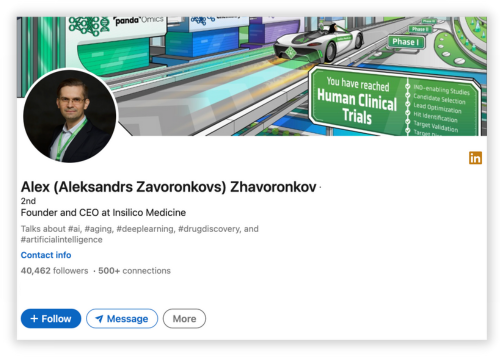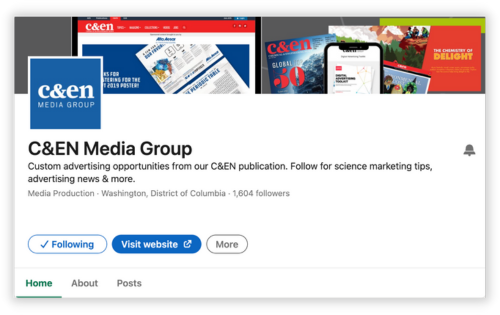Guest writer Jesse Harris is a Digital Marketing Coordinator at ACD/Labs. He has been creating internet content since 2016, and has Master’s degrees in both chemistry and chemical engineering. He loves helping STEM experts communicate their science more impactfully.
LinkedIn is a powerful platform for scientists to expand their professional network, gain visibility, and showcase their research. Traffic from LinkedIn is also high value, which offers huge opportunities for science marketers. In fact, a HubSpot study found that LinkedIn was nearly three times more effective at generating leads than Facebook and Twitter. However, the platform can be intimidating due to its connections to work and career.
Not sure where to start on LinkedIn? Follow the tips below to make authentic connections that can generate buzz for your research and quality leads for your business, or brand.
LinkedIn 101 for Scientists (and Anyone Else)
No matter who you are or how you want to use LinkedIn, there are a handful of guidelines you can follow that will help you get started:
- Fill out your profile if you haven’t already. This guide from LinkedIn will help, even if you aren’t looking for a new job.
- Consistency is rewarded. For best results try to post once a day.
- Progress takes time – don’t expect to build your network overnight.
- Posts with media generally perform better than plain text, though there are plenty of text-only posts that do well.
- Be friendly, polite, don’t swear, and don’t be pushy.
LinkedIn is a multi-functional platform. You can write long or short posts, use images, videos, and more. This means you have a lot of freedom in how you use the platform, but it also means you aren’t given a direction. Long-time LinkedIn regulars can also obsess over changes in the algorithm, trying to figure out how to maximize engagement.
As a new user, it’s best to stick with the formats where you are most comfortable. Post regularly, build relationships, and take inspiration from how others are using LinkedIn. Experimentation is key!
Connecting with Scientists on LinkedIn
Science is a big subject. Chemists, biologists, and physicists are interested in totally different topics. To be successful on LinkedIn, it is usually best to focus on a niche topic. How narrow should your niche be? This is a tough question, and you will need to figure it out by trial and error.

It is best to start with a sub-discipline, such as “organic chemistry,” or “oncology,” and see how people respond. Within that subject, you can post about anything: personal experiences in that field, commenting about industry news, or deep dives into interesting papers. Once again, experimentation is critical!
While most of your posts should be on your focus area, don’t feel that 100% of your posts need to be on that topic. General interest content about leadership, motivation, or business is popular. You can write about your personal life, current events, or pop culture. There are very few “LinkedIn isn’t Facebook” police out there.
The real value of LinkedIn comes from building genuine connections with folks in your field. Along with posting yourself, try developing relationships with others who post on similar subjects. Follow them, comment on their posts, and attempt to connect. Most people (especially scientists) love meeting people who share their interests.
Social Marketing on LinkedIn
What if you want to use LinkedIn to promote your company? Don’t act like a robot that just pushes your company’s products or content. Instead, be friendly, intelligent, and participate in conversations relevant to your target audience. This can have a solid brand effect!
Imagine you work at Acme Scientific Glassware. You regularly share interesting facts about glassware, tips on maintaining glassware, and post pictures of unusual custom glassware. Even if you never mentioned that you worked at Acme, folks would see your affiliation in your profile, and would associate your company with glassware expertise. People might even message you questions that could lead to sales.
You can use your LinkedIn page as a place to share your company’s content or products, but it should be a minority of your posts. LinkedIn also appears to de-prioritize content that sends people off the platform, so linking to your website might decrease your reach. Attempt to optimize for “zero click” consumption if possible.
What about company pages? Generally, people prefer to follow and interact with people rather than businesses, so it is better to focus on your personal page before dedicating your time to the company page. You can follow a similar playbook for your company page, though I would avoid posts on tangential topics such as pop culture.
Building a thriving LinkedIn company page is difficult, but it can help support your LinkedIn paid ads and LinkedIn recruiting. If you want to develop a more involved LinkedIn marketing strategy, this guide goes into more detail.
Have Fun!
LinkedIn offers many opportunities for scientists to network and share their research. While the platform is a bit unintuitive, it is genuinely fun if you can make solid connections. You also have an opportunity to contribute to scientific discourse and build community, which is rewarding in its own way.



















